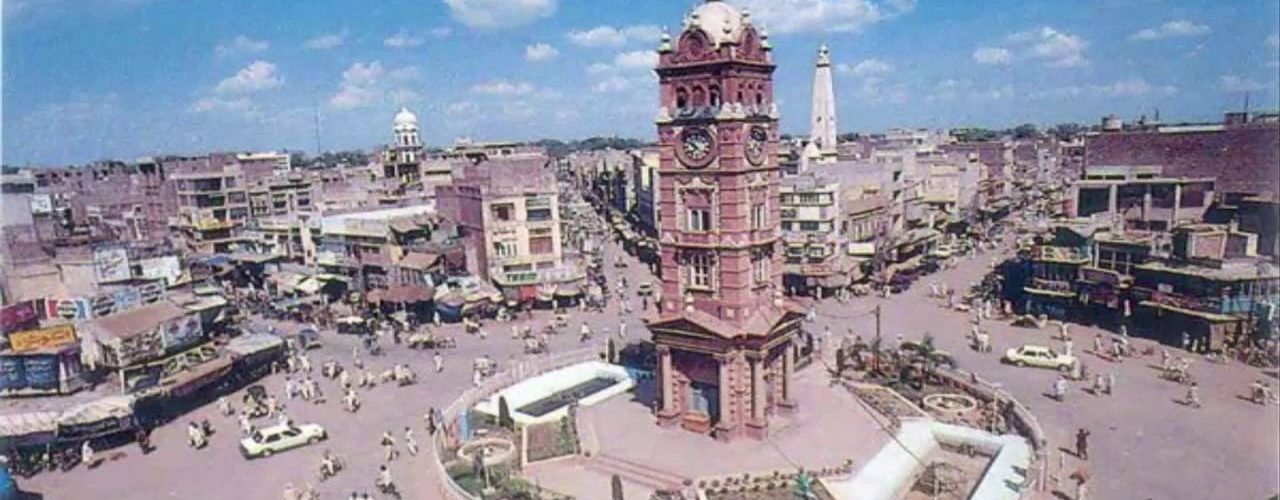Faisalabad (Formerly Lyallpur) is a road and railway junction, which lies in an area watered by the Lower Chenab Canal. Cotton, wheat, vegetables, and fruits are grown there and the city is also an industrial centre with railway-repair yards, engineering works, and mills that process sugar, flour, and oil seed. Produce includes super phosphates, cotton and silk textiles, hosiery, dyes, agricultural equipment, and ghee (clarified butter). Faisalabad is the site of the University of Agriculture, founded in 1909.
Faisalabad is called Manchester of Pakistan. It is the main Industrial city of the central Punjab province. The city is famous for its Textile mills. For general visitor Faisalabad is famous for its eight bazaars.Location
Faisalabad is situated 225-miles (360 kilometers) south of Islamabad. The Faisalabad district lies from 30-35 to 31-47 north Latitudes and 72-73 to 73-40 east longitudes. Gujranwala And Sheikhupura districts bound it in the north. In the East by Sheikhupura and Sahiwal districts. In the south By Sahiwal and Toba Tek Singh districts and Jhang district is to its west.
The city covers an area of 5,856 Square kilometers. The city is linked to m-2 motorway (Islamabad-Lahore motorway) with m-3 motorway section (Pindi-Bhattian-Faisalabad motorway).
Hotels in Faisalabad
Serena Hotel Faisalabad FaisalabadDee Continental Hotel FaisalabadNational Hotel FaisalabadHotel One Faisalabad FaisalabadTours
Tour in Faisalabad
Half day 4 Hours
Visit clock tower bazaar in Faisalabad Jinnah Garden and University of Faisalabad. Later continue to the newer shopping area and visit the shops there.
Full day Lahore Excursion 8-9 Hours
Drive to Lahore visit Lahore fort Badshahi Mosque Anar Kali Bazaar, Delhi Gate bazaar and Wazir Khan Mosque. Lunch at a famous local restaurant later visit Lahore museum and return to Faisalabad in The Afternoon.Transfers
Airport to Hotel
Faisalabad to Lahore
Faisalabad to Multan
Faisalabad to Wahgah Border.
History
Pre-independence
The city was founded by the British Lieutenant Governor of the Punjab, Sir Charles James Lyall for whom it was originally named Lyallpur. Prior to the British making the area into an urban center, it largely consisted of various villages. However, the construction of various canals allowed the area to be irrigated. After the founding of the city, people were invited to the city with promises of land if they were to work it. This allowed the city to grow rapidly.
The city of Lyallpur came into being in 1880. The city which is now well known as “Manchester of Pakistan” for its industrial activity, was nothing but a desolate tract of land 100 years ago. It did not rain here for weeks together and when it rained, the water vanished in the city land in no time. There was no village nearby. The city centre of Lyallpur was designed by Captain Poham Young, to imitate the Union Jack with eight roads radiating from a large clock tower in the centre to eight separate bazaars.
In 1895, the rail link between Wazirabad and Lyallpur was effected. The building of Railway Station wanted time, therefore, a Goods train wagon served at Lyallpur Railway Station (still present today). As the progress of colonisation stepped up Lyallpur was given the status of Tehsil of Jhang District and its administration carried on the tents on the old Theh (Mound) of Pucca Mari near Tariqabad. The Majestic Clock Tower of Lyallpur was constructed out of the funds raised by the Sikh Zamindars who collected it at a rate of Rs. 18 per square of land. The fund thus raised was handed over to the Municipal Committee which got it completed.
In 1902, the population of the town had exceeded 4,000. A considerable number of houses and shops to cater to the ordinary needs of the population had constructed. In 1903, decision to have an agricultural college was made. In the very next year, 1904, the new district of Lyallpur was constituted comparing of Tehsils of Lyallpur, Samundri and Toba Tek Singh with a subtehsil at Jaranwala which later turned into a full fledged Tehsil. In 1906, the District Headquarters began to function at Lyallpur and all the bazars and mohallas within the bounds of circular road were nearing completion and city began to spread outside the circular road. The Town Committee which has come into being in 1904, was upgraded as Municipal Committee in 1909 and Deputy Commissioner was declared to be the lst Chairman. In 1916, the grain market saw its shops surging with customers. In the same year the civil Hospital was expanded. With the advent of the World War II, the political awakening sprinkled its influence over the city. Revolutionary meetings were held. Fiery speeches were made. Slogans were written on the walls.
In 1943, Mohammed Ali Jinnah came to Lyallpur and addressed a gathering of over 2 million in Dhobi Ghat Grounds. When Pakistan was accepted as an independent unit, the Muslims of Lyallpur held special prayers and distributed sweets and food among the poor on March 3, 1947.
Post Independence
The city grew into a strong industrial and agricultural centre and on independence of Pakistan it was a major urban area. After independence, the city of Lyallpur marched rapidly on the path of progress. The city which had so far been known for its grain market, became a great commercial and industrial centre. The population of the city which in 1901 hardly touched the figure of a few thousands soared up to millions. Medical and educational level was lifted up. In 1977, the name of the city was changed to Faisalabad, after the name of the late king of Saudi Arabia, Shah Faisal-bin-Abdul Aziz. In 1985, the city was upgraded as a division with the districts of Faisalabad, Jhang and Toba Tek Singh.




Add comment